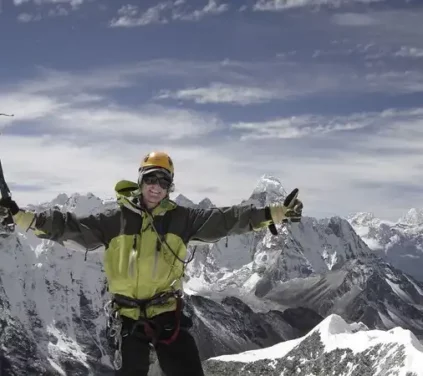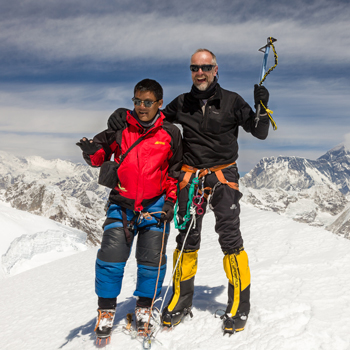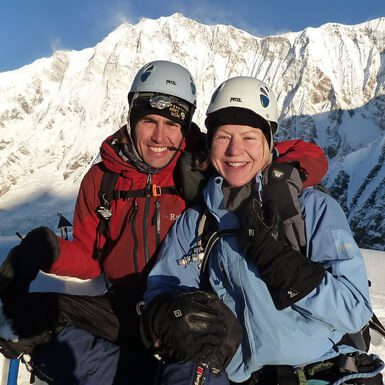Based on 9 reviews
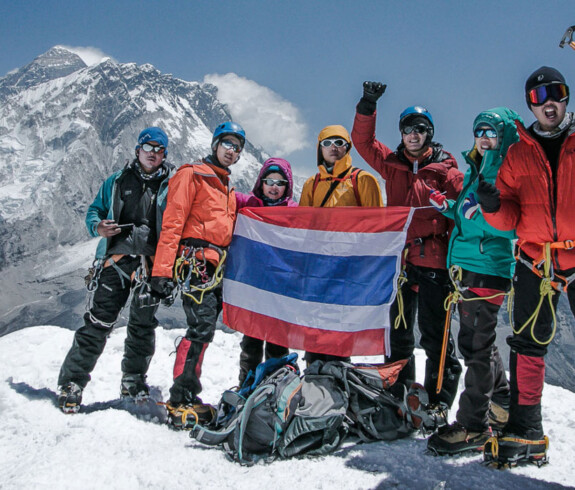
Lobuche Peak Climbing
Climbing Lobuche peak in 18 days with Everest Base Camp Trek
Duration
Meals
- 18 breakfast
- 15 Lunch
- 15 Dinner
Accommodation
- 3-night hotel
- 15-night eco-lodge
Activities
- Peak Climbing
- Trekking
- Sightseeing
SAVE
€ 700Price Starts From
€ 3500
Overview of Lobuche Peak Climbing
Peregrine Treks offers this dark rocky triangle-shaped peak climbing to aid the experienced trekking and climbing guide/Sherpa with impeccable service. Lobuche Peak Climbing has two summits, Lobuche East and Lobuche West, respectively, with 6119m and 6145m. These summits are interconnected by the same ridge, which has a relative gap and contrasting difference in distance between them, though they are connected.
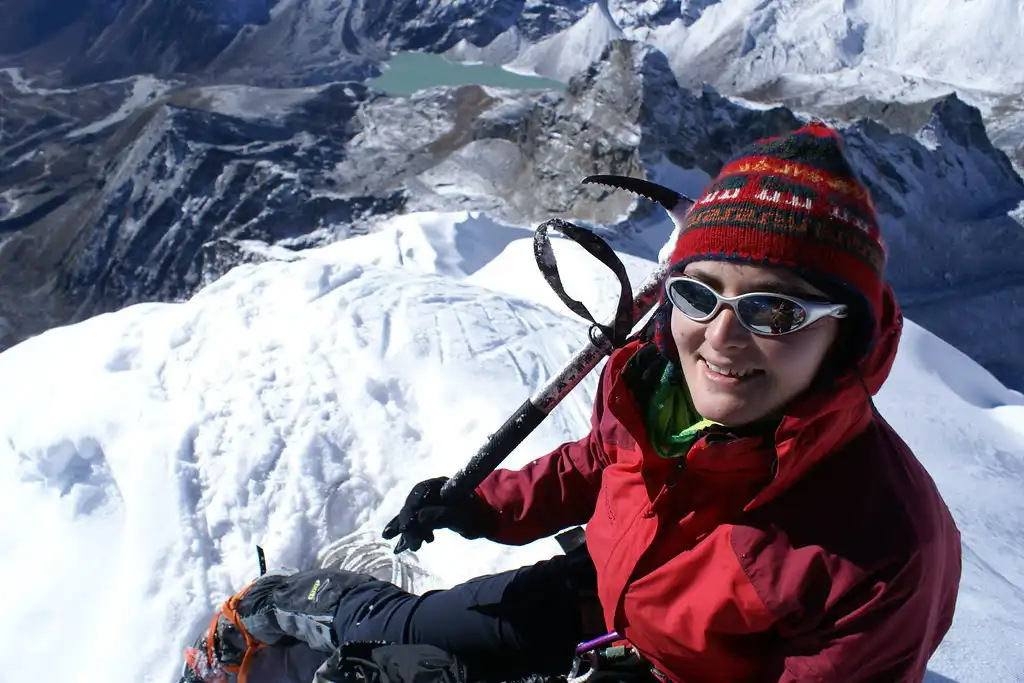
The eastern Lobuche can be summated with a trekking peak permit, while the west Lobuche requires an climbing permit. The shape of the Lobuche is like a solid triangle and can be best viewed from Pheriche, while the eastern ridge of the Lobuche rises from the Khumbu Glacier. The skyline glaciated the southwest face, and the skyline formed ascending south peaks.
Lobuche Peak Climbing Highlights
- Summit Lobuche Peak — 6119 meter
- Fly to and from Lukla — you can see the fantastic view of the Himalayas from the flight.
- Namche Bazar — Capital of Sherpa and Tengboche Monastery
- Visit Everest Base Camp and Mount Everest view from Kala Patthar
- Stunning Himalayan view and Khumbu Ice Fall
- UNESCO World Heritage Sites
One of Nepal’s most adventurous and breathtaking peak climbing is the ascent of Lobuche. Located along the ridge of Sagarmatha National Park in the Khumbu Region, Lobuche Peak rises directly to 6119 meters.
Typically, while climbing Lobuche Peak, there are two summits: Lobuche East (6119m) and Lobuche West (6145m). Similarly, the Lobuche West passes through the Khumbu glacier. In this area, ascending through majestic glaciers will give you an incredible sense. Your view of several glaciers and mountains will be breathtaking.
Climbing the Lobuche Peak can be considered a little strenuous compared to other trekking peaks in Nepal. Expert help and support crew are needed; therefore, the expert Sherpa and highly experienced Peregrine Treks & Expedition trek planners offer safe passage and summit of the peak.
Book these fantastic trekking peaks to create the most adventurous memory of your life. If you are searching for the best mountain to prepare for the climbing to other higher peaks of Nepal, starting from Lobuche Peak could be the best answer. Our website must be informative, but some travelers could have many more questions. Please do not hesitate to contact us.
Our trek will bring us through charming Sherpa villages, where you’ll explore a taste of how humans survive some of the most inhospitable homesteads on Earth. Their hospitality claims no language, and your photographs will be memorable and unique.
Spring (March to May) and autumn (September to November) are the best months for Lobuche Peak Climbing. Although Lobuche Peak Climbing can be taken during winter, the cold temperature might not suit climbers.
Detail Itinerary of Lobuche Peak Climbing
Day 1: Arrive in Kathmandu (1400m)
You’ll be arriving in Kathmandu on this day, and our representative will pick you up from the airport in a private vehicle and transport you to one of the city’s most amazing three-star hotels.
Accommodation: The Everest Hotel
Meals: Not Included
Day 2: Flight to Lukla from Kathmandu and Trek to Phakding (2,652m)
After a lovely breakfast, we will fly from Kathmandu to Lukla in 35 minutes. Tenzing Hillary Airport, the riskiest airport in the world, will greet us. We will trek for 4 hours to Phakding on the same day. We will continue to make plans for the next day’s trek while staying the night in Phakding.
Accommodation: Local Lodge
Meals: Breakfast, Lunch, Dinner
Day 3: Trek from Phakding to Namche Bazaar (3,440m)
After a delicious breakfast and a gorgeous morning, we are ready to trek to Namche Bazaar. We’ll stop in Monjo village as we pass through for a fantastic meal at one of its teahouses. Similarly, after a 5 to 6-hour trek, we will arrive at Namche Bazaar, a stunning hamlet. At the Namche Bazaar, we’ll spend the night.

Accommodation: Local Lodge
Meals: Breakfast, Lunch, Dinner
Day 4: Acclimatization day at Namche Bazaar
We’ll rest today in Namche Bazaar as we explore the surroundings. Similarly, we’ll be stopping by a few local monasteries.
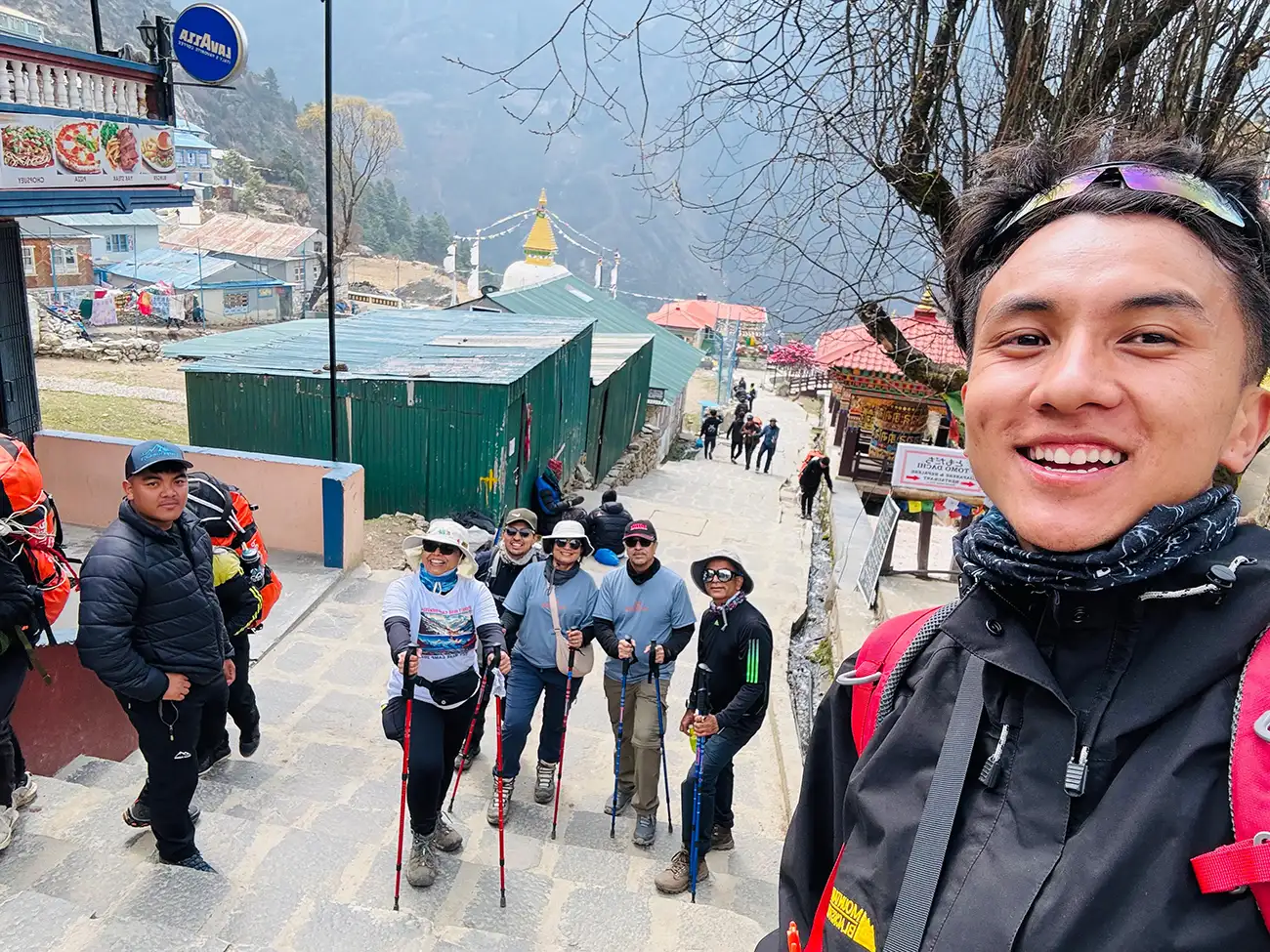
Likewise, we won’t spend any time going on a trek near the Everest View Hotel to take in the views of many mountains, including Ama Dablam, Makalu, Lhotse, and Cho Oyu.
Accommodation: Local Lodge
Meals: Breakfast, Lunch, Dinner
Day 5: Namche Bazaar to Tengboche (3,870m)
After a lovely breakfast, we will leave Namche Bazaar and trek to Tengboche. Within 6 hours of trekking, we will reach Tengboche by passing through the wide valley of Gokyo Valley and following the Bhote Koshi River’s margin. Similarly, we will inspect Tengboche Monastery, one of the most remarkable monasteries in Nepal. We’ll spend the night at Tengboche.
Accommodation: Local Lodge
Meals: Breakfast, Lunch, Dinner
Day 6: Tengboche to Dingboche (4,360m)
The lovely breakfast and spectacular dawn will give us tremendous energy for our trek. In the same vein, we will be monitoring the particular trial known as the Musk Dear trial as it leaves the Deboche settlement. We will then proceed towards the Dingboche after having a meal at one of the teahouses and crossing the numerous bridges. After a 4 to 5-hour trek, we will arrive at the magnificent village of Dingboche and spend the night.
Accommodation: Local Lodge
Meals: Breakfast, Lunch, Dinner
Day 7: Acclimatization day in Dingboche
At Dingboche, this is a relaxation day. We will tour the area and take in the scenery, including the deep Chukkung and Pheriche Valley. The breathtaking vista of the Himalayas, including Ama Dablam, Kanchenjunga, Lhotse, and Everest, will enthrall us to the uttermost.
Accommodation: Local Lodge
Meals: Breakfast, Lunch, Dinner
Day 8: Dingboche to Lobuche (4,940m)
Finally, we will trek to Lobuche, which is our first target. We will arrive in Lobuche and spend the night there after a 5- to 6-hour trek from the Khumbu Glacier starting point.
Accommodation: Local Lodge
Meals: Breakfast, Lunch, Dinner
Day 9: Lobuche to Everest Base Camp and back to Gorak Shep (5,170m)
We will start our trek to our next destination with the morning breakfast. Ascending straight uphill from within the Khumbu Glacier within 5 hours, we will end up at Everest Base Camp. Likewise, after exploring EBC, we will return to Gorak Shep within 3 hours.
Accommodation: Local Lodge
Meals: Breakfast, Lunch, Dinner
Day 10: Gorak Shep to Kala Patthar and downhill to Lobuche (4940m)
After having a fantastic morning breakfast in the teahouse, we will trek straight uphill to Kala Pathar. Taking unique pictures for memories, we will return to Lobuche within 3 hours of the trek and stay overnight at Lobuche.
Accommodation: Local Lodge
Meals: Breakfast, Lunch, Dinner
Day 11: Lobuche to Lobuche Base Camp (4,950m)
The short, 1-2 hour trek from Lobuche to Lobuche Base Camp will kick off the rest of our adventure on this lovely day.
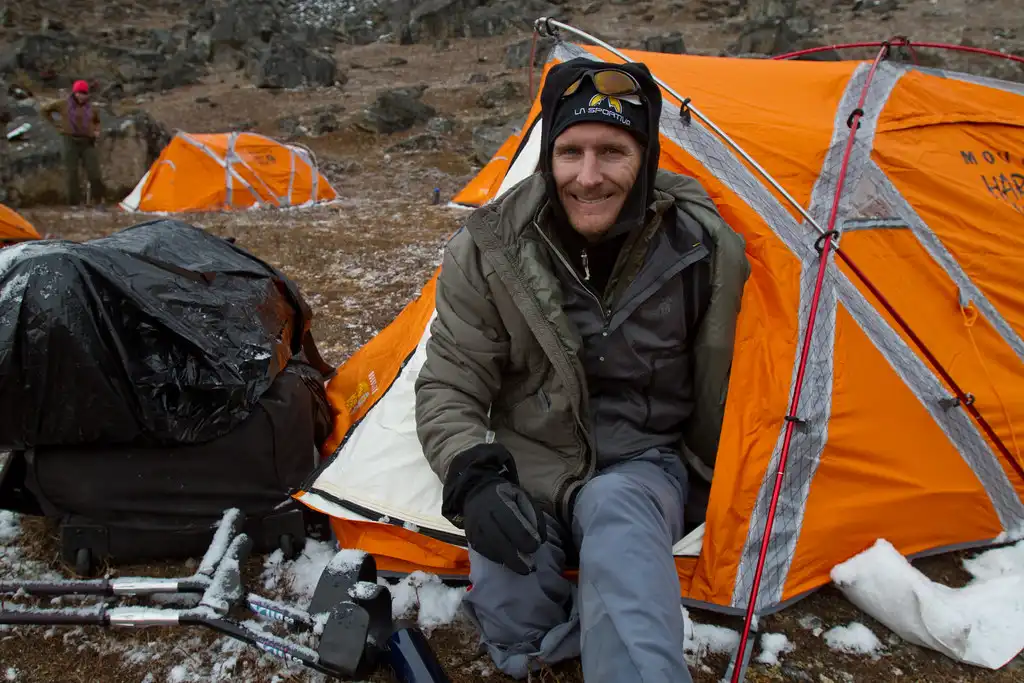
Going to Lobuche Base Camp, you can vividly glimpse Ama Dablam and Tawache. Lobuche Base Camp will be our base for the night.
Meals: Breakfast, Lunch, and Dinner
Accommodation: Tented Camp
Day 12: Lobuche Base Camp to High Camp (5,400m)
We will reach the Summit after a 3 to 4-hour trek from Lobuche base camp, passing through several glacier lakes. Similarly, we will either camp out or stay in one of the teahouses in the High Camp.
Meals: Breakfast, Lunch, and Dinner
Accommodation: Tented Camp
Day 13: High Camp to Summit and trek back to High Camp (6,119m)
This day’s trek will be a little more complicated than other days. We will move toward the Summit after a lovely breakfast. The tremendous challenges for us will be the slippery terrain and steep hills. After more than eight hours of trekking, we will have reached the peak. We get a clear view of numerous peaks, including Everest, Lhotse Kanchenjunga, and many others. We’ll snap a few pictures and then head back to high camp, where we’ll stay overnight.
Meals: Breakfast, Lunch, and Dinner
Accommodation: Tented Camp
Day 14: High Camp to Orsho (4,160m)
After a lovely breakfast, we’ll pass Lobuche East Base Camp on our trek to Orsho. We may reach Orsho in less than 5 hours after trekking through the Chukkung Valley. We’ll spend the night at one of the Orsho teahouses.
Accommodation: Local Lodge
Meals: Breakfast, Lunch, Dinner
Day 15: Orsho to Khumjung (3,780m)
We will reach Khumjung after a four-hour downhill trek via the ijma River. We would go to lovely Tengboche and Tengboche towns en route. Today, we’ll spend the night at Khumjung Valley.
Accommodation: Local Lodge
Meals: Breakfast, Lunch, Dinner
Day 16: Khumjung to Lukla (2,860m)
After a fantastic breakfast, we will trek Lukla. The valley has a picturesque village and dense pine forest from Khumjung to Lukla. We’ll stop at one of the teahouses along the trail for lunch. Similarly to that, we will reach Lukla after 7-hour trekking.
Accommodation: Local Lodge
Meals: Breakfast, Lunch, Dinner
Day 17: Fly back to Kathmandu from Lukla
After a lovely meal in the morning, we will fly for an astonishing 35 minutes before landing in Kathmandu.
Accommodation: The Everest Hotel
Meals: Breakfast
Day 18: Kathmandu Sightseeing
On this day, we will provide you with a private vehicle and convey you to the stunning traditional temples of Kathmandu, including Swayambhunath, Pashupatinath, and Patan Durbar Square. We’ll also spend a few nights in Thamel, where we’ll bid you a quick farewell.
Accommodation: The Everest Hotel
Meals: Breakfast
Day 19: Departure
We will drive you in our vehicle three hours before your flight after a sumptuous breakfast. You can depart Nepal on this day by setting up the necessary paperwork.
Meals: Breakfast
Customize this trip with help from our local travel specialist that matches your interests.
Includes & Excludes
What is included?
- Airport picks up and drops and transfers to hotel.
- Guided sightseeing in Kathmandu valley with entrance fees
- Hotel in Kathmandu, teahouses for Trekking, and tented accommodation during Lobuche Peak climbing
- Three times meals during the Trekking and climbing period
- All necessary staff with experienced English-speaking climbing guide, cook, assistant climbing leader ( one assistant guide for 5 trekkers), and Sherpa porters
- Kathmandu – Lukla – Kathmandu flight ticket
- All necessary paperwork like Lobuche Peak Climbing Permits, TIMS, Local Tax, etc
- Mountaineering camping and climbing equipment high-quality equipment like North Face or Mountain Hardwar tents, mattresses, and kitchen equipment
- Travel and rescue arrangements provide
- Welcome and farewell dinner
- Exclusive Medical Kit Bag
- All government and local taxes
What is excluded?
- Nepal Visa fee and International airfare
- Excess baggage charges
- Accommodation and meals in Kathmandu because of early arrival, late departure, and early return from Lobuche Peak Climbing
- Altitude chamber or oxygen
- Travel and rescue insurance
- Personal climbing equipment
- Personal climbing guide on your request
- Personal expenses like phone calls, laundry, bar bills, mineral/boiled water, shower, etc
- Tips for a trekking crew member
Departure Dates
We also operate Private Trips.
Route Map
Trip Information
Lobuche Peak Climbing Cost
Lobuche Peak Climbing will cost USD 2450 with Peregrine Treks and will take 19 days to complete. Several variables affect Lobuche’s price, some of which are listed here.
Visa and Permit Cost
To enter Nepal, a visa is necessary, and a visa fee must be paid. Only citizens of India are eligible for free entrance without a visa charge. Since the visa cost varies depending on how long you stay, 15 days will cost you about USD 30, while 30 days and 90 days will cost you USD 50 and 120, respectively.
A necessary permit called the Lobuche Peak Climbing Permit also adheres to the Nepal Mountaineering Association‘s standard. The price of a permit varies by season, which is listed below.
Spring Season – USD 250
Summer Season – USD 70
Autumn Season – USD 125
Winter Season – USD 70
Similarly, according to NMA, the local area permit would cost you about USD 20.
Moreover, you will cross the Sagarmatha National Park during Lobuche Peak Climbing. Additionally, there requires a permit to pass through this region, and the permit fee differs with the nationality.
Locals – Free
SAARC National – USD 15
Foreign Nationals – USD 30
Guides and Porters
Your abilities may be put to the final test during the trial that involves traversing glaciers. A guide and porters are also required for this. Anytime you need assistance, they will do their best to assist you. Your daily expenses for the guide will be around USD 25 to USD 35, while your daily expenses for the porter will be around USD 15 to USD 25. Similarly, guides serve as a means of introduction to the community and a source of information about many aspects of the natural world encountered when trekking. Porters assisting you during the Lobuche Peak Climbing can carry up to 25 kg of hefty backpacks.
Accommodation and Meals
You may choose from hotels and inns in Kathmandu that provide high-quality amenities for between $10 and $200. There will only be teahouses offering the most fantastic services to you when you climb the mountain from Namche Bazaar. Moreover, you will stay at one of these teahouses for an average daily rate of between $5 and $7. Big hotels and lodges won’t be present in this area either. Every teahouse will be available to help you from Tengboche to Lobuche. Similarly, daily meal costs, which include breakfast, lunch, and supper, range from $5 to $10. This includes typical snacks like Momo, Chowmien, Sukuti, thukpa, and lunch staples like Dal Bhat Tarkari.
Supplementary Costs
Set up $50 to $100 daily for unexpected expenditures when climbing Lobuche Peak. You may bring extra food, water bottles, and equipment on occasion. Additionally, you could discover unique artwork and crafts in the Everest Region that symbolize magnificent ancient Buddhist culture and that you wish to bring home with you. In a similar vein, supplementary costs also include internet access, sim cards, and hot showers.
Lobuche East Vs. Island Peak
The Eastern Himalayas of Nepal’s Lobuche East and Island Peak are among the most significant climbing peaks. Both are lies in the Everest region and share similar adventure natural elements. The ascent of each peak is also remarkable in its way.
Difficulty Level
These two mountains have summits higher than 6000 meters above sea level. Both of these summits are moderately tough. However, Lobuche Peak is slightly more challenging to climb than Island Peak. The Lobuche Peak East is a feasible triangular-shaped peak with a difficult ascent up a straight slope. It is simple to ascend the trail that leads to Island Peak. Similarly, anyone may climb Island Peak, regardless of experience level. Therefore, Island Peak is simpler to climb than Lobuche East.
Best Season to Climb
Keeping that in mind, both peaks symbolize the Everest region. It implies that the local climate fluctuates a much. Nepal’s eastern Himalayas often experience the monsoon before the rest of the country. Lobuche Peak and Island Peak, in the exact location, mirror similar weather and climatic trends. The two ideal seasons are spring and autumn for climbing Lobuche Peak and Island Peak. Winter and summer seasons might not be appropriate for these two summits either. You will also see glaciers on Lobuche East and Island Peak and a clear view of Everest, Makalu, and other Himalayan peaks in the spring and autumn.
Physical Fitness and Training
Physical fitness is crucial if you plan to trek any of the peaks in the Everest region. These summits rise beyond 6000 meters, necessitating extraordinary perfection in pre-trek exercise and high fitness. Lobuche Peak is more demanding to climb than Island Peak, so you will exert the most energy while trekking. You will need to be conscious of your physical fitness level since Lobuche East will put your trekking abilities to the test. The energy required for trekking will be similar to that of Lobuche East in the case of the island summit; however, you must undergo rigorous preparation before mounting both peaks.
Culture and Tradition
Sherpas serve as the embodiment of the Everest region. Similarly, Lobuche East Island Peak is comprised of and has the same culture, heritage, and religion. You will be astounded by the antique historical artworks and crafts associated with Himalayan groups in Buddhist culture stretching from Namche Bazaar to Dingboche settlements. Identical to how both peaks’ itineraries pass through Tengboche, you will see the monastery, a significant tourist destination. The Lohsar festival is the main festival for most locals, Sherpa. A similar cultural impact is present in both Lobuche East and Island Peak.
Everest Base Camp Trek with Lobuche Peak Climbing
One of the most remarkable treks will include the Everest Base Camp Trek with Lobuche Peak Climbing. This climbing explores a sizable portion of the Everest region, allowing you to understand the central themes from significant perspectives.
Lobuche 2 May
Lobuche Peak Climbing in May is like having the chance to wrap up your excursion before the end of spring. The ideal month to trek Lobuche 2 will be May. The region’s typical temperature will be around -2 to -9 degrees Celsius. Like the temperature, the humidity will range from 75% to 80% at this time of year. This season’s rainfall at Lobuche Peak will begin with 108mm. The snowfall in May also ranges from 780 to 797mm. Furthermore, depending on the weather, the length of the day will be between 12 and 13 hours. Similarly, the UV index in May will be 1, necessitating the use of appropriate sunblock.
Lobuche Weather
According to the four seasons, the weather in Lobuche may be categorized. Lobuche has several weather patterns during each season, as mentioned here.
Weather in Spring Season
This season essentially covers the months of March through May. The weather will be perfect for the Lobuche trek. The temperature will be around -2 to 5 degrees Celsius during the day and between -8 and -2 at night. You may also see spectacular mountains in precise crystal detail, with surrounding flora developing on its own and a lush landscape. You’ll enjoy your trek more in the chilly wind and warm sun.
Weather in Autumn Season
The Lobuche Peak trekking season’s optimum time is often in the fall. The weather will be clear after the chilly days with a pleasant wind and a definite sun. The temperature at night will be about -10 degrees Celsius, while during the day, it will be around 2 to 5 degrees Celsius.
Weather in Summer Season (Monsoon)
The summer season includes the months of May through August. The challenge will be pretty treacherous, making it more adventurous. The east Himalayas will be marginally visible due to clouds and fog. Extreme sunshine and temperatures of 10 degrees Celsius are forecast for the day, while -5 degrees Celsius are forecast for the evening.
Weather in Winter Season
The region will see significant cold from late October to late December. You’ll have to put more effort into ascending because of the bitter wind and deep snow. Similarly, you may ascend in the winter if you want to experience the snowy atmosphere. Around -10 to -15 degrees Celsius will be the afternoon temperature. Additionally, the temperature at night is below -20 degrees Celsius.
Frequently Asked Questions
Yes, the Lobuche East summit offers an awe-inspiring panoramic view of the majestic Mt. Everest and other notable peaks such as Nuptse, Pumori, Lhotse, Ama Dablam, Gyachung Kang, Cho Oyu, Makalu, and more.
As we begin on the challenging ascent to the summit, we come prepared with oxygen cylinders in tow. The decision to utilize this supplementary equipment is contingent upon one’s physical aptitude and stamina level. Nonetheless, a significant number of climbers manage to successfully reach the pinnacle of Lobuche peak without resorting to such measures.
Prior trekking experiences and a thorough understanding of possible obstacles during a Himalayan expedition can prepare you for an exciting and challenging Lobuche Peak Climbing. Lobuche Peak is an excellent choice for those new to peak climbing as it offers a great opportunity to gain valuable experience in this field.
It is important to note that those who have not yet reached the age of 16 are prohibited from ascending 6,000-meter peaks in the Himalayan region of Nepal. This regulation has been implemented to ensure the safety and well-being of young climbers, as these peaks can present significant challenges and risks even for experienced mountaineers.
All trekkers and climbers must obtain comprehensive travel insurance that covers emergency helicopter evacuations. The costs of such insurance are relatively affordable, especially compared to the exorbitant expenses of an evacuation during an expedition. Failing to secure adequate travel insurance would result in bearing the entire financial burden of evacuation and treatment expenses, which can amount to tens of thousands of dollars. Therefore, it is highly recommended to purchase travel insurance beforehand to avoid any unforeseen financial liabilities in case of an emergency.
Certainly, our comprehensive package covers the climbing permit’s cost, and our Peregrine team will handle all the necessary arrangements, including transportation services.
Kindly fill out the booking form on the respective trip’s page to reserve this trip. You may select the size of your group and the necessary services to obtain an accurate price quote catered to your needs. To proceed, click the BOOK NOW/INQUIRE FORM button and provide us with the required information. To confirm your booking, we will need a 20% deposit for your trip, a scanned copy of your passport, a JPG format of your passport photo suitable for printing, and your flight itinerary.
Reviews on Lobuche Peak Climbing
unforgettable trip of Nepal
The peregrine team totally knocked it out of the park to make our group’s holiday unforgettable! They were super professional and always on top of communication, which meant that we could just sit back, relax, and enjoy our adventure. The guides, porters, and staff were all amazing – we didn’t encounter a single problem during our trekking. And booking everything was a breeze, thanks to Pradip, who was always there to lend a hand and answer any questions we had. We couldn’t recommend the Peregrine team enough – they truly went above and beyond to make our trip one for the books!

Dorothy S. Gilbert
Bingamon Road Conneaut, United StatesAmazing Lobuche Peak Climbing
Oh my goodness, let me just tell you how incredible the Peregrine trek was! I cannot recommend it enough – seriously, if they offer any trek, go for it! Pradip and his team are absolute gems and are 100% dedicated to ensuring you have the time of your life. Our guide was an absolute superstar and was always there to help with anything that came up during the trek. And don’t even get me started on the porters – they were such a blast to be around and always energized us. Honestly, our trek wouldn’t have been anywhere near as amazing without them.

Gladys T. McAlpin
Atlanta, USAHighly recommend trip
I just completed an amazing climb of Lobuche Peak, and it was honestly one of the coolest experiences of my life. The views from the top were breathtaking, and my feeling of accomplishment was beyond words. The guides and porters on my team were the best – they were so knowledgeable and helpful throughout the entire journey. I felt completely safe, and everything was so well-organized. If you’re up for a challenging and super rewarding adventure in the stunning Himalayas, I’d definitely recommend giving this trek a go!

Lily Burns
WalesLobuche Peak Climbing
Are you planning to venture into the mountains but feeling unsure about it? Don’t worry; just call Pradip, and he’ll take care of everything. He’s a pro at checking all the details and helping you with whatever you need. I gotta admit I had high hopes for my trip to Nepal, but it exceeded all expectations thanks to Pradip’s expertise. It was my first time there, but I felt completely at ease. I can’t recommend Peregrine Treks enough!

Ryan Ingram
United KingdomRichmond, France
I just wanted to share my excitement about my upcoming adventure! I’ve booked a trip to climb Lobuche Peak in the first week of April 2023 with Peregrine Treks and let me tell you, the communication with Pradip has been outstanding. He’s been so courteous, professional, and always quick to respond. I can’t recommend this company enough! Cheers to new adventures and great experiences!

Rabican Tachel
Incredible Climbing
It was an incredible climb up Lobuche Peak, and I had the pleasure of being guided by the wonderful team at Peregrine Team. They were so friendly, patient, and helpful every step of the way – from the first moment, we set out until we reached the summit. Even though the trek was challenging, it was an experience I’d never forget.

Delmar Nadeau
FranceLobuche Expedition with Peregrine
I just finished up the Lobuche peak climb, and dude, it was sick! Got to chat with the locals, and the views were straight-up stunning. The climb was tough but doable, and the feeling of reaching the top was like nothing I’d ever experienced before. If you’re into adventure and want a mountain experience, I highly suggest hitting up the Lobuche peak climb. Shout out to Peregrine for making it happen! Seriously, go check it out.

Nadine Vogler
GermanyIncomparable trip
Experience the thrill of ascending the resplendent Lobuche peak with the incomparable team at Peregrine Treks!

Christina Kaiser
Germany
